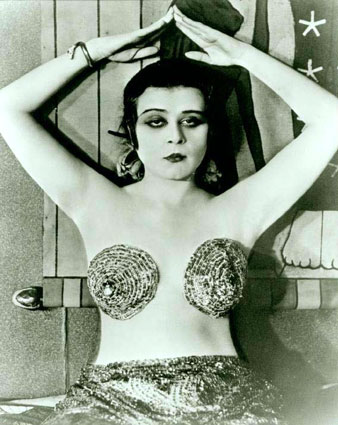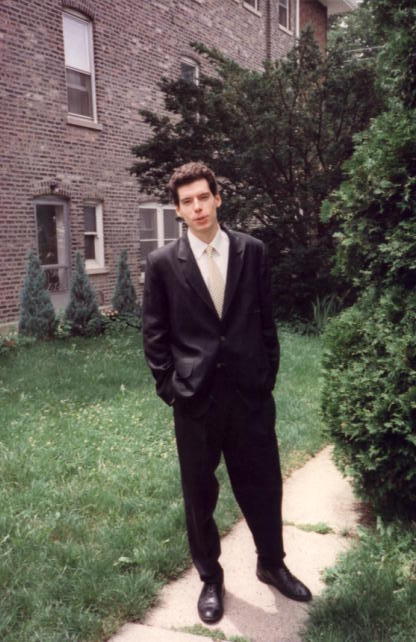
Theda Bara: The Mother of
All Sex Symbols
by Anthony Puccinelli
The mother of all sex symbols in the age of celebrity is
Theda Bara. Eve Golden's entertaining book, Vamp, is the first full-length
biography ever written on cinema's first sex symbol. What makes the book
surprising is that its subject is practically a phantom: the
first twenty-nine years of her life take up all of nine pages, as does her
twenty-nine year post-film career. Though she was born Theodosia Goodman in 1885, in
a sense she exploded into existence when she chose the screen name Theda
Bara (an anagram for "Arab Death"), and became a star in 1915. Theda
contributed to her own legend by pretending to be someone other than a shy,
Jewish girl from Ohio, and now that shy, Jewish girl cannot be reclaimed,
even by her biographer. What's left is the star.
In only one of Bara's four surviving films does she play
the vamp role for which she was acclaimed. Released in 1915, "A Fool There
Was" was an instant sensation, and exploited the Victorian idea that
sexual activity drains one's life force. As the seminal vampire, Theda
slouches past one haggard wreck of a man after another. Since she is never
shown sucking their blood, the implication is clear: all are
plainly victims of her omnivorous sexual appetite. In the film's most
famous scene, a jealous, abandoned lover draws a pistol to shoot the vampire.
Imperious and unafraid, Theda commands: "Kiss me, my fool!" Unable to
shoot her and unable to live without her, he blows his brains out. In the
film's climax, the wife of a diplomat brings her daughter to see her father.
He hugs his child passionately, but then Theda appears at the top of the
stairs, one ghostly white arm dangling over the banister like the snake of
temptation in the garden of Eden. Helpless, the diplomat embraces
his humiliation as his humiliated wife and daughter leave the den of
iniquity.
Plainly, the wife and child are stand-ins for the social
order. They are the face of social responsibility, and function as witnesses
to how far the diplomat will go in his quest for sensual satiation.
Therefore, their rejection is a rejection of the social order, and their
humiliation is not only suggestive of Theda's thrilling appeal, but part
of her appeal. As Golden writes, one of Theda's costumes for "A Fool There
Was" was a one-piece bathing suit at a time when "women were still being
arrested for indecent exposure in many towns for wearing these garments."
The scene featuring the suit was censored, as was the scene in a later film
where Salome kisses the decapitated head of John the Baptist. In
defense of her vamp roles, Theda said, "Believe me, for every woman
vampire, there are ten men of the same type."
Theda is heavier than the sex symbols of today, and her
acting may appear florid and overblown to modern eyes. Inevitably, standards
of beauty and styles of acting change over time. Perhaps a hundred years
from now, Jennifer Lopez's name will also have faded slowly and inexorably
from humanity's memory. Or perhaps, like Theda, she will be caricatured on a
United States first class stamp and immortalized in collector's albums
forever.
 In the introduction to Vamp, film historian
Robert Brichard writes longingly: "Oh, how I wish I could see Theda Bara
in Cleopatra! As Eve Golden recreates the opening scene in words, the
intense black-rimmed eyes of Theda Bara rivet me to my theatre chair, and
again work their magic." This man's desire is truly refined torture, since
all that remains from the lost film Cleopatra are a few stills showing
Theda in her "snake-bra: a halter-top consisting of two intertwined snakes
with rather impolite rubies serving for eyes." As Golden notes, the costumes
worn by Theda in Cleopatra bear a startling similarity to those adorning
Madonna in her racier videos, but obviously Madonna would never be able to
provide Brichard the satisfaction Theda could, because a component of
his desire is its unattainability. Decadence has been defined as a
beautiful thing that's dying. In this sense, worshippers of silent film are
the truest decadents of all, since more than 80% of American films made
during the first twenty-five years of cinema are lost forever. At this moment
a nitrate print of Cleopatra may be languishing in a collector's attic
or a film vault, slowly crumbling to dust.
In the introduction to Vamp, film historian
Robert Brichard writes longingly: "Oh, how I wish I could see Theda Bara
in Cleopatra! As Eve Golden recreates the opening scene in words, the
intense black-rimmed eyes of Theda Bara rivet me to my theatre chair, and
again work their magic." This man's desire is truly refined torture, since
all that remains from the lost film Cleopatra are a few stills showing
Theda in her "snake-bra: a halter-top consisting of two intertwined snakes
with rather impolite rubies serving for eyes." As Golden notes, the costumes
worn by Theda in Cleopatra bear a startling similarity to those adorning
Madonna in her racier videos, but obviously Madonna would never be able to
provide Brichard the satisfaction Theda could, because a component of
his desire is its unattainability. Decadence has been defined as a
beautiful thing that's dying. In this sense, worshippers of silent film are
the truest decadents of all, since more than 80% of American films made
during the first twenty-five years of cinema are lost forever. At this moment
a nitrate print of Cleopatra may be languishing in a collector's attic
or a film vault, slowly crumbling to dust.
Watching A Fool There Was in this context is
a multifaceted experience: historical and heartbreaking, sensual and
silly, pathetic and profound. One responds to Theda's impact as sexual being
supreme with a simultaneous awareness of her death, made vivid by
the encroachment of time in the flickering print. Part of the appeal of
old records is the hiss of the years, the sound of elapsed time in the
grooves. Similarly, watching Theda, one draws closer to the screen to
try to see her more clearly, but the image becomes diffuse, like a Seurat
painting up close. She is ever evasive, eluding us as surely as she does her
biographer. And therein lies the poignance, for in trying to embrace her
-- in trying to preserve her image, awaken her memory, and reanimate her
appeal -- we reject the void that awaits us all. Vamp is a celebration of
Theda Bara, and therefore a monument to both the ephemeral and the
eternal: the mortality of man and woman and the immortality of
desire.
©2001 by Anthony Puccinelli






